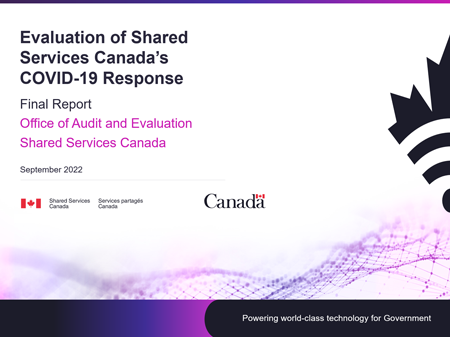Evaluation of Shared Services Canada’s COVID-19 Response
Table of contents
- Executive Summary
- The COVID-19 Context and the SSC Response
- Evaluation Scope and Methodology
- Responsiveness and Effectiveness
- Supporting Factors for Responsiveness and Effectiveness
- Mixed and Hindering Factors for Responsiveness and Effectiveness
- Sustainability
- Efficiency
- Emerging Issues and Considerations
- Conclusions and Recommendations
Office of Audit and Evaluation
Shared Services Canada
September 2022
Executive Summary
This evaluation assessed the responsiveness, effectiveness, sustainability and efficiency of the department’s response to the COVID-19 pandemic. Its purpose is to inform decision-making and to support operational improvements. This report presents the evaluation findings, conclusions and recommendations. The period under review began with the shift to remote work in March 2020 and continued to the end of data collection in March 2022.
The evaluation found that Shared Services Canada (SSC) played a responsive and effective role supporting federal departments and agencies in providing critical services to Canadians. The pandemic placed unprecedented demands on the Government of Canada IT infrastructure as departments and agencies rapidly implemented new programs and services to support Canadians. SSC rose to the challenge and pivoted quickly to shifting needs and requirements. In many ways, one could say it was SSC’s finest hour.
As SSC’s strategic vision, SSC 3.0 was the cornerstone for enabling responsive and effective action. It provided a strategy for an Enterprise approach to information technology by concentrating work on three service transformation priorities: networks and security, workplace collaboration tools, and digital service delivery. These priorities allowed SSC to focus its operational efforts and actions around the most critical aspects of the pandemic response. By focusing on these priorities, SSC demonstrated remarkable speed, agility and dedication in its delivery of pandemic-related critical services.
For results, SSC does not currently measure the impact of its performance and its contributions to the achievement of business outcomes in partner organizations. Instead, customer satisfaction is used as a proxy to measure the successful delivery of immediate and intermediate outcomes arising from the provision of SSC services and programs. Based on data collected from customer satisfaction instruments, SSC’s support for departments and agencies to deliver critical services during the pandemic was effective. At the same time, there is a need to collect outcome data in order to enable meaningful measurement of performance and impacts.
Many key factors facilitated the responsiveness and effectiveness of the department including SSC 3.0. There were also certain internal coherence challenges that may have hindered performance.
SSC’s COVID-19 prioritization framework successfully enabled the implementation of pandemic-related priorities. While effective during the initial response, this framework was perceived by internal and external interviewees as no longer sufficient to facilitate effective service delivery in a post-crisis context. A review of SSC’s business request prioritization strategy is needed to support effective allocation of scarce resources.
The speed of service that SSC demonstrated in responding to urgent needs during COVID-19 was unsustainable. As demand for SSC’s services has continued to increase, stakeholders expressed concerns that SSC did not have the capacity required to meet current and future demand. While the disequilibrium between capacity and demand was not unique to COVID-19, the impact of the pandemic exposed this gap.
Given the sustainability challenges, it will be imperative for SSC to use its existing resource envelope in the most efficient manner. The evaluation found opportunities to improve efficiency in the various stages of the business intake process. A review of the business intake process is needed to further identify and address the areas of inefficiencies.
During data collection for the evaluation, interview and survey respondents brought forward several issues concerning the strategic direction of the Enterprise approach. While these issues were not directly related to SSC’s COVID-19 response, they could have important implications for future operations. Specifically, partners expressed concerns that SSC was too focused on operational needs and not enough on their strategic needs. They asked for more and better information on the Enterprise approach, including future milestones and the new Enterprise Service Model. They also asked for more balance between standardized and customized solutions. Going forward, there is a need to improve communications on the Enterprise approach to the provision of SSC’s IT infrastructure services.
Recommendations
- Review and revise SSC’s demand prioritization strategy to align resource allocation with SSC’s longer-term core responsibilities to ensure the highest value activities can be delivered.
- Engage selected partners in the development of outcome measures of SSC’s performance. These measures are intended to demonstrate how SSC supports departments and agencies in delivering mandates and how SSC contributes to the delivery of GC priorities.
- Review the business intake process to identify and address inefficiencies. This could include:
- Ensure consistent use of business request documentation and tools, such as the Business Intake Tracking System.
- Further streamline and standardize processes to expedite time required to complete business requests.
- Develop clear, well-documented workflows (such as organizational charts and contact information) to allow appropriate identification and engagement of service lines.
- Develop criteria and mechanisms to reduce the number of business requests submitted by partners.
- Develop a communications strategy for the Enterprise Service Model that clearly details future changes to service delivery and the strategic milestones to support longer-term planning.
The COVID-19 Context and the SSC Response
In March 2020, as the work-from-home order came into effect for most federal public servants, tens of thousands of employees started working remotely. This put an unprecedented demand on Government of Canada (GC) networks and bandwidth, remote access capabilities, collaboration and communication tools, and other support services for all GC employees.
At the same time, government departments and agencies were rapidly implementing new programs and services to support Canadians and businesses during the pandemic. Partner organizations looked to SSC to adapt its network services and to improve digital capacity in critical areas. As the IT service provider to 45 departments and agencies, SSC was presented with unprecedented demand across all service lines.
SSC rose to the challenge. The actions and activities to support the Government of Canada’s COVID-19 response were demonstrated through the following three areas: emergency governance, client service delivery, and support to employees.
Emergency Governance
In March 2020, SSC’s Strategic Emergency Management Plan quickly elevated to level 2 and level 3 to activate the Emergency Operations Team and the Departmental Emergency Response Group, respectively. This governance structure ensured a clear mandate throughout SSC’s initial response. The Departmental Emergency Response Group provided executive decisions at the departmental level that included determining and implementing pandemic response priorities, whereas the Emergency Operations Team managed the SSC’s pandemic response effort at the working level.
In July 2020, as SSC’s Strategic Emergency Management Plan returned to level 1, SSC transitioned from a crisis response mode to enhanced monitoring. Since then, SSC has started coordinating business resumption activities to prepare for the eventual return to regular operations, while at the same time performing enhanced monitoring activities.
Client Service Delivery
Under SSC’s client service delivery approach, each partner organization was served by a Client Executive team. During various stages of the COVID-19 pandemic, SSC’s Client Executives worked closely with partner organizations to understand their emerging needs to support the delivery of critical services to Canadians.
The unprecedented demand for digital services had a significant impact on the volume and types of business requests that the department received. While some previously submitted service requests were no longer available for delivery due to the sudden shift to telework, there was an influx of service requests as a result of GC’s pandemic response. In addition, there was also a sudden shift in service use, where most business requests involved service lines that supported networks, remote access, and collaboration tools.
To support unprecedented demand for network services, the department accelerated bandwidth improvements and upgraded network performance. This ensured that quality of service was maintained while handling increased internet traffic. To support remote access requirements, SSC significantly increased Secure Remote Access capacity. This allowed government employees to continue to deliver services to Canadians and maintain operations while working from home. To support partner operations and to enable government employees to continue working collaboratively in a virtual working environment, the department acquired a suite of collaboration and communication tools and enabled modern telecommunication features and services. To enable government departments and agencies to deliver critical services to Canadians, SSC worked closely with partners to ensure the provision of reliable solutions and system support.
There were many examples of SSC supporting the delivery of critical services to Canadians:
1
SSC increased the digital infrastructure capacity of the Canada Revenue Agency to support its distribution of critical emergency benefits such as the Canada Emergency Response Benefit (CERB).
2
SSC increased the Employment Insurance program infrastructure and supported Employment and Social Development Canada to handle unprecedented benefit claims.
3
SSC supported Public Health Agency of Canada and Canada Border Services Agency to implement the cloud-based application, ArriveCan. This helped streamline arrivals into Canada during the pandemic.
Supporting SSC Employees
SSC implemented various solutions to support its employees during the pandemic. At the onset of COVID-19, SSC took measures to keep its employees informed about the pandemic; address their most pressing needs; and support their transition to remote work. This included supporting employees’ immediate workplace safety and security concerns. In addition, the department also provided training and resources to support managers and team leads in managing remote teams during the pandemic. Recognizing the potential impact of COVID-19 on employees’ mental health and well-being, SSC’s Mental Health Program provided a wide range of events, resources, initiatives and training opportunities to support a psychologically healthy and safe workplace throughout the pandemic.
In addition, SSC increased its effort in creating an inclusive work environment for all SSC employees. In 2021, the President and the Executive Vice-President put in place a Diversity Council to provide concrete direction to address systemic barriers within SSC. The Department also provided various training, tools, and resources to managers and employees to foster awareness on issues related to diversity and inclusion.
Evaluation Scope and Methodology
Evaluation Scope
The December 2021 mandate letters directed all departments to draw on lessons learned from the pandemic to further adapt and develop more agile and effective ways to serve Canadians. It is expected that this evaluation of the response to the COVID-19 pandemic will help support SSC in meeting this commitment.
The evaluation assessed the responsiveness, effectiveness, sustainability, and efficiency of the department’s response. Its purpose was to inform decision-making and support program improvements.
The period under review began with the shift to remote work across the Government of Canada in March 2020 and continued to the end of the data collection phase in March 2022.
This evaluation was managed and conducted internally by the Office of Audit and Evaluation. The evaluation team was supported by external expertise to conduct certain data collection activities for certain lines of evidence.
This evaluation addressed the following key questions:
Responsiveness
How responsive was SSC to the urgent and changing demands of the COVID-19 context?
What were the factors that supported or hindered responsiveness?
Effectiveness
How effective were SSC’s actions in responding to the pandemic?
Sustainability
To what extent were the actions taken in the COVID-19 response sustainable?
Efficiency
At this point, what are the opportunities to improve efficiency?
In the Government of Canada, evaluation is the systematic and neutral collection and analysis of evidence to judge merit, worth or value. Evaluation informs decision making, improvements, innovation and accountability.
Evaluations typically focus on programs, policies and priorities, and examine questions related to relevance and responsiveness, effectiveness, and efficiency. Evaluations generally employ social science research methods.
Methodology
Unlike a standard program, key program documents such as planning documents, logic models, and performance measurement frameworks did not exist for the actions taken to respond to the COVID-19 crisis. The evaluation was based on utilization-focused and mixed-methods approaches where seven different lines of evidence were used to inform this evaluation.
- Document Review
-
Relevant internal documents were reviewed including corporate planning and strategy documents, departmental result framework documents, program documents, internal review documents, employee survey reports, etc.
- Key Informant Interviews
-
Between April 2021 and February 2022, semi-structured interviews (n=38 informants) were conducted with SSC management and staff, client Chief Information Officers, and international counterparts.
- Administrative Data Analysis
-
Various datasets from the Enterprise Data Repository were analyzed, including the Future of Work Surveys, the Customer Satisfaction Feedback Initiative surveys, and the Service Delivery General Satisfaction Surveys.
- Literature Reviews
-
Three literature reviews were conducted to examine the emerging literature and lessons learned in Canada, the United States, and Europe for building employee engagement in light of the pandemic. An in-house literature review on the role of information technology played during the COVID-19 response was also conducted.
- International Comparative Analysis
-
A comparative analysis of COVID-19 responses provided by the public IT sector in selected countries was conducted. The analysis identified best practices and lessons learned that could be relevant for SSC. The countries included Germany, Denmark, Australia, and the Netherlands.
- Case Study
-
A case study of the Business Request process was conducted to identify efficiency issues. The case study included a review of available documentation (n=18), data analysis of the Business Intake Tracking System, and key informant interviews (n=9) with relevant stakeholders
- Client Survey
-
Client organizations were surveyed to identify the extent to which SSC’s pandemic response supported their evolving digital and program needs. The survey had a 55% response rate (n=23).
Responsiveness and Effectiveness
During the urgent crisis of COVID-19, the traditional line between addressing changing client needs (relevance and responsiveness) and delivering effective solutions was blurred. Evaluation evidence suggests that SSC delivered pandemic-related critical services in a responsive and effective manner, demonstrating its ability to provide uninterrupted and reliable services to meet urgent demands.
SSC worked with speed and agility to support the delivery of pandemic-related critical services and to support remote work for government employees
In 2019-2020, SSC’s ongoing government-wide efforts (the Enterprise approach) laid the groundwork for responding to the unprecedented demands of the COVID-19 pandemic. It supported a sudden shift to remote work across government departments, an increased need for digital service delivery, and rapid deployment of new services, benefits and tools to support Canadians.
Working with unprecedented speed and agility, service lines and service management functions came under significant pressure in the first weeks of the pandemic. Timelines for initiatives that would normally have taken months or years to complete were compressed into days and weeks.
For example, in March 2020, as the work-from-home order came into effect, SSC rapidly improved bandwidth by 66% and Secure Remote Access capacity by 111% to ensure there was a reliable network for public servants to connect from home.
SSC also rapidly deployed Microsoft 365 and other workplace collaboration tools (such as additional teleconference services) to increase remote work capacity and maintain efficient service delivery. From May 2020 to September 2020, SSC accelerated implementation of Microsoft Teams from two departments to 35 to provide a secure environment for digital communication and collaboration. In addition, SSC added conferencing and contact centre service capacity improvements that enabled a 320% increase in use.
In interviews and surveys, partner organizations consistently mentioned that the department quickly deployed services to support organizational capacity at the onset of the crisis and exceeded client expectations for speed of service delivery.
Data analysis of the business request process revealed a clear reduction of the median time to resolve business requests during the pandemic. While the reduction of processing times started prior to the pandemic, the trend continued throughout the first year of the COVID-19 response.
“The fact we were able to mobilize the entire workforce onto the network so quickly is a testament to how fast SSC helped us achieve that. Considering where we started from before COVID, that was amazing.”
“SSC’s speed of completion for all urgent requests in support of crisis response activities was absolutely incredible. SSC worked tirelessly, all hours of the day, throughout the crisis.”
2020-21 saw a reduction in median time (days) required to process business requests
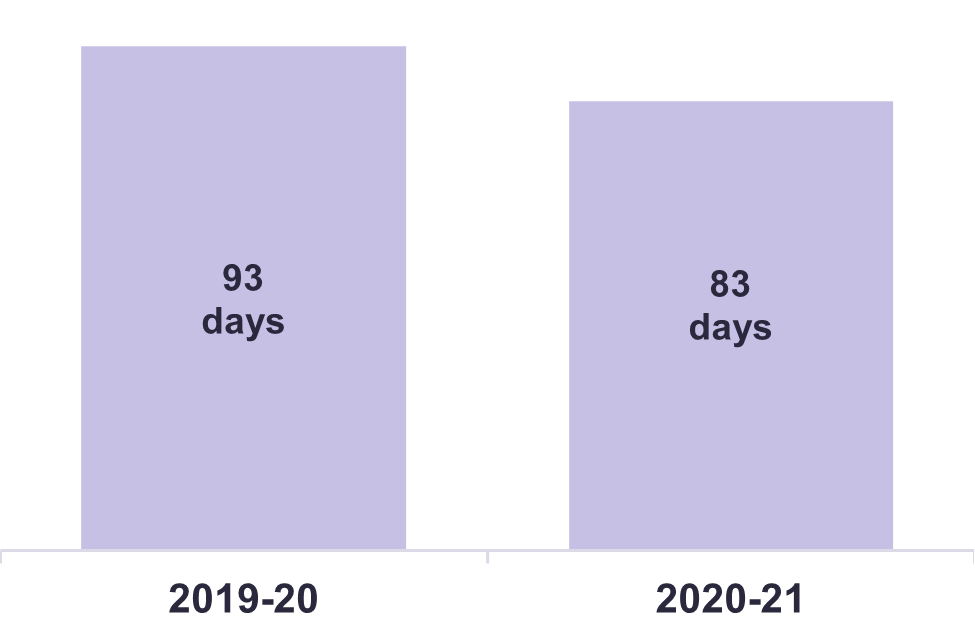
Long Description
- 2019-20
- 93 days
- 2020-21
- 83 days
Customer satisfaction increased significantly
For results, SSC does not currently measure the impact of its performance and its contributions to the achievement of business outcomes in partner organizations. Instead, customer satisfaction is used as a proxy to measure the successful delivery of immediate and intermediate outcomes arising from SSC services and programs. There is a need to collect outcome data in order to enable meaningful measurement of performance and impacts.
Despite these caveats, customer satisfaction ratings demonstrated an increased satisfaction with the speed of service delivery at the height of the COVID-19 response compared to the pre-pandemic performance. According to the Service Delivery General Satisfaction Surveys, the overall satisfaction of partner organizations with the amount of time it took to receive services increased from 59% in January 2020 to 69% in July 2020.
Some SSC interviewees stated that the way SSC quickly and effectively responded to COVID-19 demonstrated its ability to provide uninterrupted services to meet urgent demands. This has made SSC’s strategic vision, namely the Enterprise approach, more credible for its partner organizations.
“SSC’s COVID response was phenomenal.”
“SSC did a fantastic job. There was a rapid response for COVID-related needs – it was very successful and provided very good results.”
“We proved that SSC 3.0 is a model that works and allows us to be more agile and responsive. Now our client is onboard on the enterprise approach, they see the value.”
Partner satisfaction in time required to receive SSC services drastically increased since the pandemic
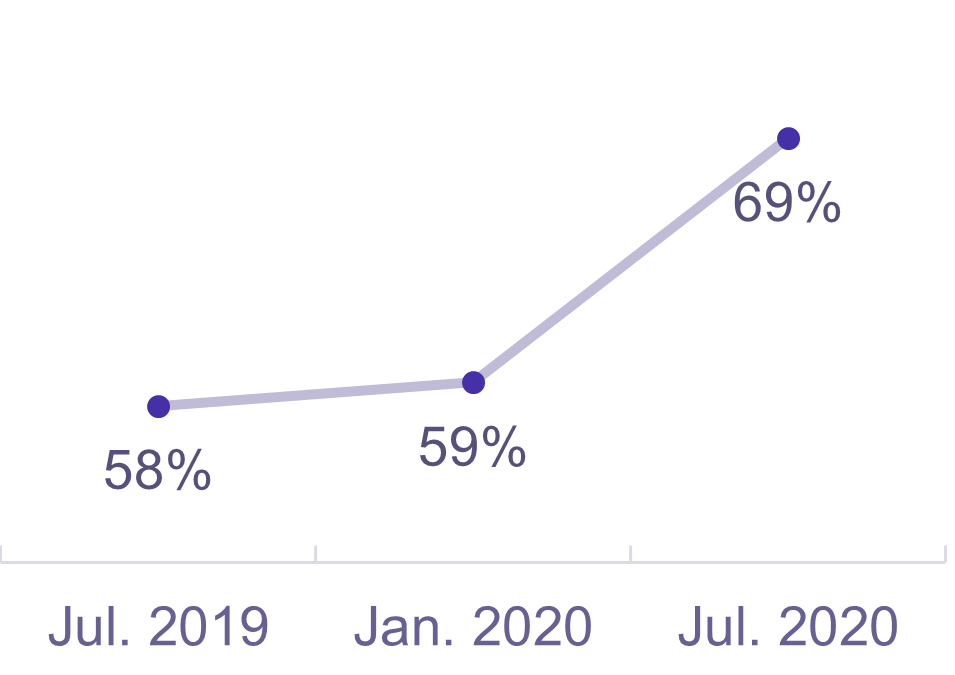
Long Description
- July 2019
- 58%
- January 2020
- 59%
- July 2020
- 69%
Key Supportive Factors For Responsiveness and Effectiveness
The evaluation identified several factors that facilitated the responsiveness and effectiveness of the department.
Many factors facilitated the responsiveness and effectiveness of SSC’s COVID-19 response
There were many factors that consistently facilitated the responsiveness and effectiveness of the department. The evaluation identified eight key contributing factors.
These factors covered a variety of perspectives, ranging from the development of strategic direction to practices for day-to-day operations.
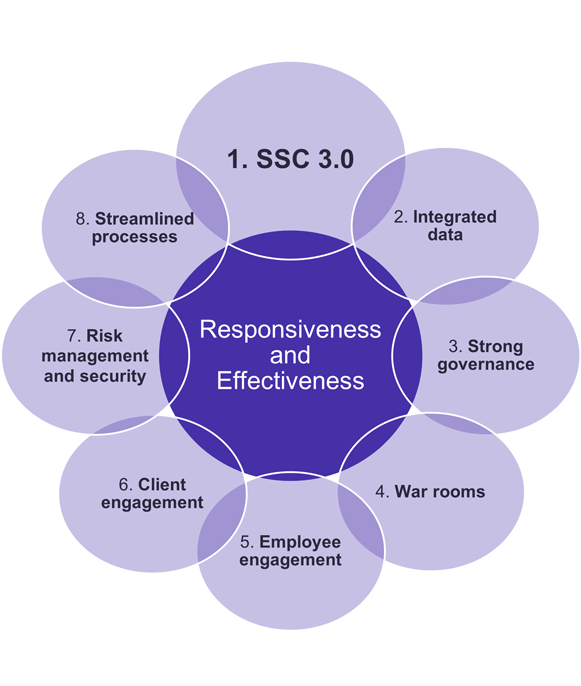
Long Description
Responsiveness and Effectiveness
- SSC 3.0
- Integrated data
- Strong governance
- War rooms
- Employee engagement
- Client engagement
- Risk management and security
- Streamlined processes
Factors facilitating responsiveness and effectiveness
1. SSC 3.0 priorities were foundational to the success of the COVID-19 response
Launched in spring of 2019, prior to the pandemic, SSC 3.0 is SSC’s strategy for service delivery. SSC 3.0 defines a whole-of-government Enterprise approach to modernize and consolidate the GC’s IT infrastructure. It emphasizes the transition from independent operations to common IT systems which will allow faster turnarounds, enhance collaboration, increase reliability, and reduce risk.
The development of SSC 3.0 was a key factor that supported responsiveness to the urgent and changing demands of the COVID-19 context. SSC 3.0 set out the right priorities for SSC’s COVID-19 response by providing a strategy for an Enterprise approach. This Enterprise approach concentrated work on Networks and Security, Workplace Collaboration Tools, and Digital Service Delivery. They proved to be the right priorities as they allowed SSC to coordinate its efforts and actions around the most critical aspects of the COVID-19 response.
2. The Enterprise Data Repository supported responsiveness during the pandemic
Created in January 2020 by the Data Analytics Centre of Excellence and right before the onset of COVID-19, the Enterprise Data Repository was designed to provide timely information of outages and to prioritize business requirements across the Government of Canada. Interviewees from SSC stated that the Enterprise Data Repository contributed to the department’s COVID-19 response by providing access to reliable data from integrated data sources. It supported data-driven activities such as benchmarking, forecasting, and prioritization, which led to efficient and proactive decision-making.
International Best Practice
According to the international comparison study, creating consolidated and integrated databases was a best practice that facilitated pandemic decision-making.
3. The existing emergency management process put in place organizational structures to provide strong governance
SSC’s existing emergency management process comprised of a structured, enterprise-wide approach to emergency management. Due to the urgent changes and requests associated with the COVID-19 pandemic, SSC moved from a service standard model to an emergency management model.
Throughout the evolution of SSC’s pandemic response, the SSC Strategic Emergency Management Plan was activated at various levels to provide direction and management of the department’s pandemic response. It enabled the department to quickly declare an emergency, establish an emergency governance structure, and develop the SSC Pandemic Response Plan.
4. War rooms were set up with dedicated resources to provide overall direction in coordinating the department’s Pandemic Response Plan
During the crisis phase of the pandemic, war rooms provided a centralized location for emergency response team members to collaborate, facilitate communication, share issues, solve problems, coordinate tasks, and mitigate risks. By collaborating with partner organizations, these war rooms improved SSC’s response time by resolving issues or critical incidents as they arose.
For example, war rooms established for Canada Revenue Agency significantly contributed to the successful launch of the Canada Emergency Response Benefit and helped to monitor Canada Revenue Agency’s infrastructure during the extremely high volumes of benefit applications.
International Best Practice
Very much like SSC’s war room approach, representatives from participating countries of the international comparison study mentioned the use of “hackathons” to develop pandemic solutions. Like a war room, a hackathon brought teams and stakeholders together to collaborate and facilitate problem solving.
5. Common objectives helped increase employee engagement and empowerment
Evaluation evidence suggests that there was a clear and solid understanding among managers and employees at all levels of the common objectives of SSC’s COVID-19 response, as well as the level of urgency required to achieve these objectives.
According to interviews, SSC’s leaders were perceived as readily available and accessible. They helped connect employees to the organization and to one another while supporting them in navigating high levels of uncertainty. Many interviewees stated COVID-19 highlighted the important role of the department. It also helped them realize the value of their work by aligning it with SSC’s higher values.
In Future of Work Pulse Check surveys, SSC employees reported a better understanding about their work objectives. In addition, employees reported feeling trusted, valued and having an increased sense of pride about their jobs. Interviewees also reported increased access to their senior officials and reduced hierarchy. Some mentioned that SSC’s leadership strategically delegated responsibilities down to lower levels. This practice helped to motivate and empower employees, which further helped to increase the department’s overall emergency response capacity.
SSC Employees have reported increased satisfaction with the department over time, nearing the GC average
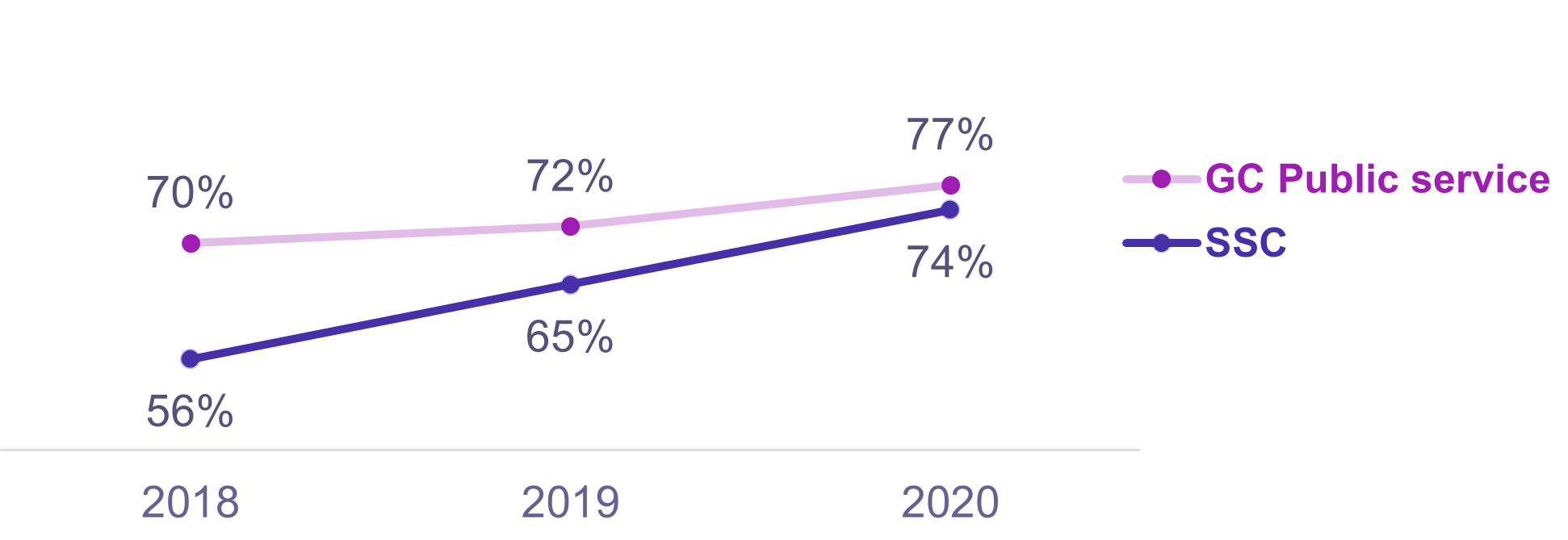
Long Description
- 2018
- SSC: 56%
- GC Public service: 70%
- 2019
- SSC: 65%
- GC Public service: 72%
- 2020
- SSC: 74%
- GC Public service: 77%
Even though many employees experienced negative impacts of COVID-19, SSC employees reported a significantly increased sense of pride to work at SSC.
According to data from various years of Public Service Employee Surveys, compared to pre-COVID-19, there has been an increase in SSC employees who:
- Felt valued at work
- Liked their job
- Got a sense of satisfaction from their work
- Were proud of their job
- Would recommend SSC as a great place to work
- Were satisfied with their organization
- Would prefer to remain with SSC, even if a comparable job was available elsewhere in the federal public service
6. SSC’s effective client service delivery approach was a key factor in the ability of the department to respond to client needs during COVID-19
According to the Service Delivery General Satisfaction surveys, engagement experience questions were where the partner organizations reported their highest satisfaction levels. Client Executive team engagement scored higher than ease of access, positive outcomes, process aspects and timeliness. Partners felt that their Client Executive understood their business needs and priorities. In addition, they also felt that their Client Executive went the extra mile to ensure their needs and priorities were met.
This finding was also confirmed by the client survey conducted for the evaluation. According to this client survey, SSC’s engagement and collaboration effort received one of the highest ratings among all surveyed topics. Most partners were either satisfied or very satisfied with SSC’s consultations and engagement with their organization in decision-making during the pandemic.
The average client satisfaction rating of Engagement has consistently outperformed all other areas
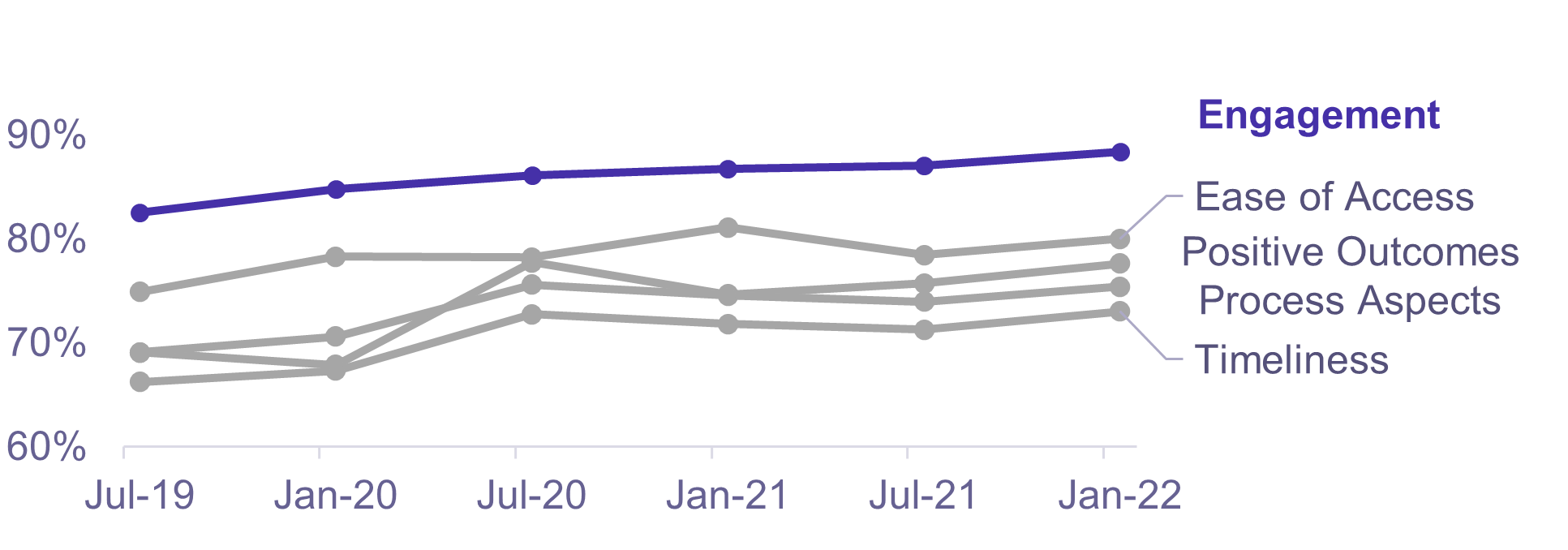
Long Description
| Engagement | Timeliness | Ease of Access | Positive Outcomes | Process Aspects | |
|---|---|---|---|---|---|
| Jul-19 | 83% | 66% | 75% | 69% | 69% |
| Jan-20 | 85% | 67% | 78% | 68% | 71% |
| Jul-20 | 86% | 73% | 78% | 78% | 76% |
| Jan-21 | 87% | 72% | 81% | 75% | 75% |
| Jul-21 | 87% | 71% | 78% | 76% | 74% |
| Jan-22 | 88% | 73% | 80% | 78% | 75% |
7. Early involvement of internal operational support functions helped to improve operational efficiency
Some interviewees stated that COVID-19 highlighted the importance of certain internal operational support functions (such as risk management and cyber security) and pushed them to the front and centre of SSC’s pandemic response. As a result, these teams were consulted and engaged earlier in the business process which was believed to have helped improve operational efficiency.
8. The removal of excess paperwork and the streamlining of certain processes helped facilitate expediency during the pandemic
In the client survey conducted for the evaluation, partners expressed that SSC demonstrated openness and flexibility by modifying certain processes to improve expediency. Most respondents (65%) agreed that SSC had adjusted processes to allow for rapid deployment of solutions during the pandemic. The same perception was also shared by interviewed partner organizations. For example, one partner gave an example of how SSC adjusted a rigid and time-consuming staff onboarding process in order to provide a timely solution. A few partners also commented on the department’s flexibility in submitting business requests by allowing supporting paperwork to be done in parallel.
Mixed and Hindering Factors for Responsiveness and Effectiveness
The evaluation identified several factors that initially played a very positive role early in the pandemic but became more mixed over time, and others that may have even hindered responsiveness and effectiveness of the department.
Certain factors had mixed or even hindering effects on responsiveness and effectiveness of SSC’s COVID-19 response
While the COVID-19 prioritization framework facilitated the implementation of a clear mandate and pandemic-related priorities during the initial response, it was perceived as no longer effective at the time of the end of the evaluation period. In addition, the focus on delivering urgent pandemic-related activities has led to delays in non-critical operations.
The evaluation also identified certain internal coherence challenges that may have hindered responsiveness and effectiveness.
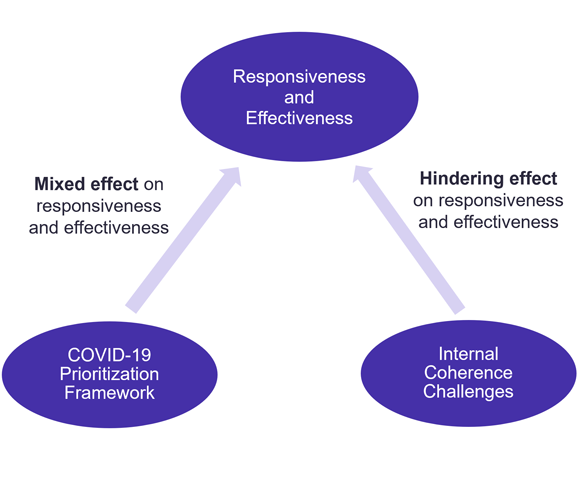
Long Description
- Responsiveness and Effectiveness
- Mixed effect on responsiveness and effectiveness
- COVID-19 Prioritization Framework
- Hindering effect on responsiveness and effectiveness
- Internal Coherence Challenges
- Mixed effect on responsiveness and effectiveness
Initially, the COVID-19 prioritization framework significantly facilitated the implementation of pandemic-related priorities
SSC interviewees who were involved in the business intake process stated the COVID-19 prioritization framework was clear, effective, and helped to facilitate the pandemic response. After implementation, the framework was regularly reassessed and improved to ensure that the needs of the evolving pandemic situation were met.
Partner organizations also expressed their satisfaction with how SSC prioritized its COVID-related services. According to the Customer Satisfaction Feedback Initiative surveys, 85% of partner organizations were satisfied the work related to COVID-19 was prioritized fairly.
Interviewed partner organizations repeatedly stated the COVID-19 prioritization framework was fair, well communicated, and well managed. The framework helped to facilitate the implementation of pandemic-related priorities during the initial response. They also mentioned SSC’s implementation of the COVID-19 prioritization framework was collaborative and consistent, with clear communication of accountability and expectations.
In addition, partners also appreciated the opportunities offered to discuss and negotiate priority levels if needed. Interviewees stated there was a shared understanding and acceptance among SSC and partners about what the COVID-19 priorities should be. It was seen as an important factor to the effectiveness of the COVID-19 prioritization framework.
“A heightened control and prioritization of changes were introduced and well managed, ensuring relevant focus on urgent matters.”
Before the Pandemic
- Priority 1
- Compressed timelines
- Priority 2
- Reduced timelines and high client priorities
- Priority 3
- Standard response
- Priority 4
- Low
➧
COVID-19 Framework
- Priority 1
- Anything related to COVID or GC Priorities
- Priority 2
- All operational demands and high client priorities
- Priority 3
- Best efforts
- Priority 4
- ON HOLD
However, there has been a significant increase in non-pandemic-related high-client-priority service requests following the implementation of the COVID-19 prioritization framework
The COVID-19 prioritization framework re-coded all service requests that had previously been considered high priority services (i.e., Priority level 1 or Priority level 2) as Priority 2. These requests were considered lower priority than all pandemic-related services (Priority 1).
There has been a sharp increase in business requests classified as Priority 2 during the pandemic
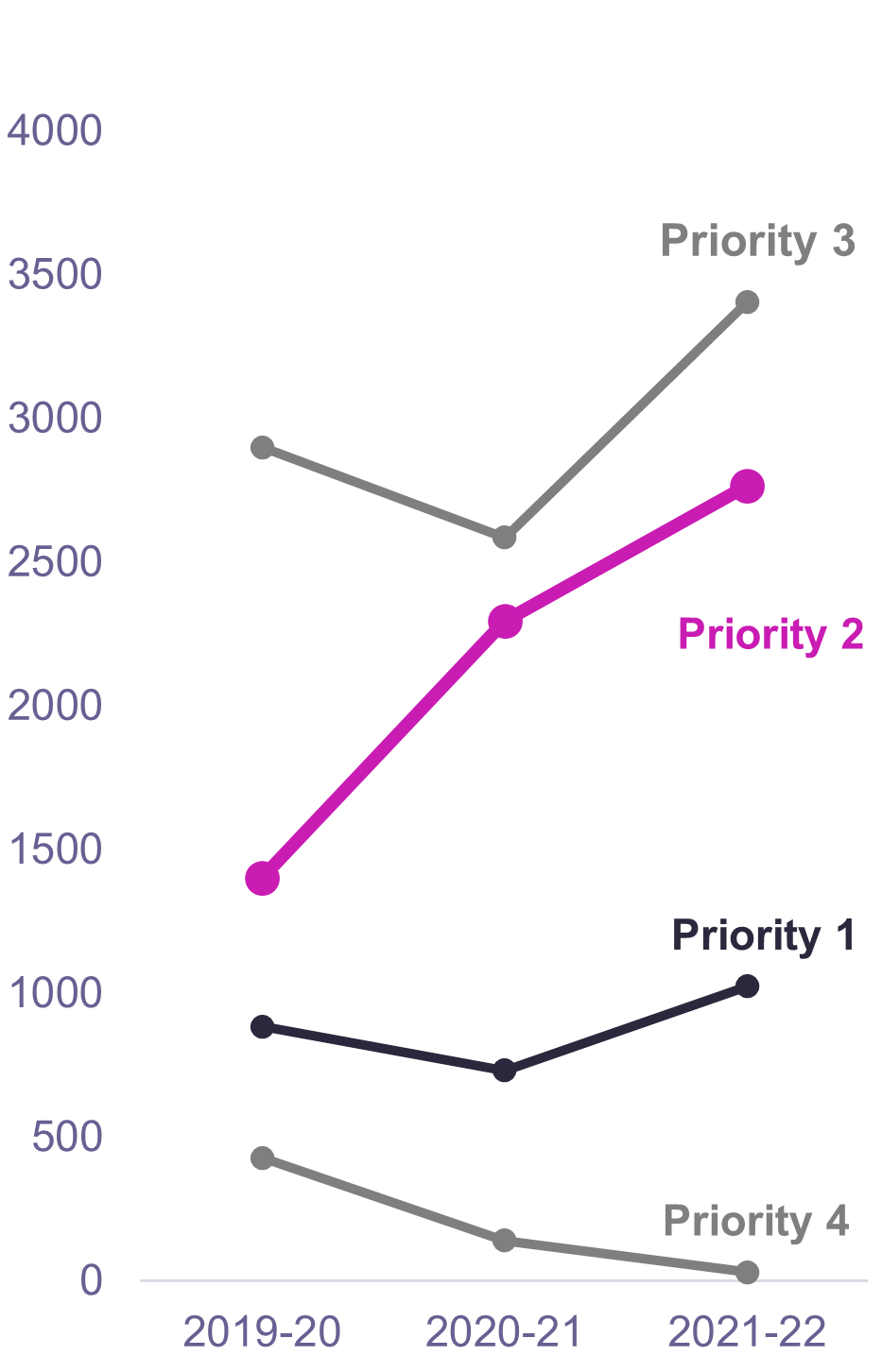
Long Description
- 2019-20
-
- Priority 1: 883
- Priority 2: 1399
- Priority 3: 2898
- Priority 4: 427
- 2020-21
-
- Priority 1: 731
- Priority 2: 2295
- Priority 3: 2585
- Priority 4: 139
- 2021-22
-
- Priority 1: 1023
- Priority 2: 2764
- Priority 3: 3403
- Priority 4: 29
Following the implementation of the new framework, there was a significant increase in non-pandemic-related high-client-priority service requests.
According to interviews, there were several factors driving this increase in high Priority 2 requests:
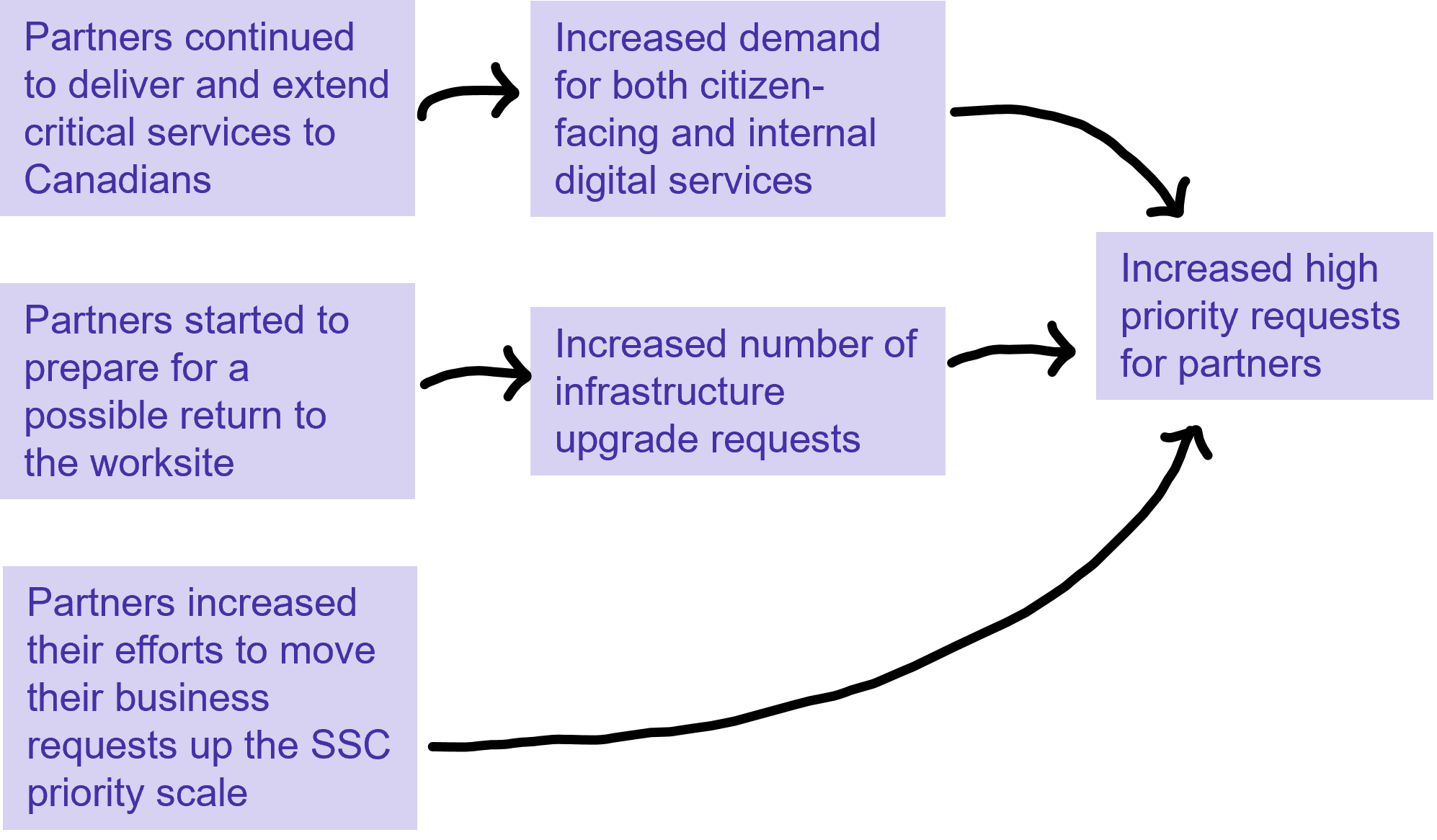
Long Description
- Increased high priority requests for partners
- Increased demand for both citizen-facing and internal digital services
- Partners continued to deliver and extend critical services to Canadians
- Increased number of infrastructure upgrade requests
- Partners started to prepare for a possible return to the worksite
- Partners increased their efforts to move their business requests up the SSC priority scale
- Increased demand for both citizen-facing and internal digital services
By the end of the data collection phase, the COVID-19 prioritization framework was perceived as no longer effective for a post-crisis context
The increase in number of high-client-priority requests created difficulties in classification efforts, even with the use of the sub-scoring framework. According to some SSC interviewees, prioritization became more and more difficult as the Government of Canada moved past the peak of the COVID-19 crisis.
In September 2021, a new sub-prioritization framework was introduced through the Enterprise Business Intake Review Board in order to address Return to Worksite activities for SSC’s partners. The new criteria assigned a sub-priority score to differentiate COVID-related activities and return-to-worksite activities.
While the original COVID-19 prioritization framework was perceived as clear and useful, the clarity and usefulness of the new sub-prioritization framework has not yet been demonstrated. Interviewees stated it was unclear and open to interpretation. As a result, it has been used inconsistently across different partners and different service requests. In addition, after applying the new sub-scoring matrix, many business requests received the same sub-score, which defeated the purpose of further classification. Overall, the perception of interviewees was the COVID-19 prioritization framework was no longer sufficient to facilitate effective service delivery in a post-crisis context.
Crisis response priorities focusing on critical services had an impact on regular operations and lower priority organizations
Crisis response priorities caused delays for regular operations
The focus on urgent pandemic-related activities led to non-critical operational services being delayed. Although some of these services were no longer required for delivery due to business transformation, most were still important to partners.
Through interviews and surveys, many partners indicated that some of their service requests that had been identified as low priority should have been marked higher. At the time of this evaluation, close to two years after the onset of the pandemic, these organizations continued to experience delays on some of their service requests.
According to the Service Delivery General Satisfaction surveys, among organizations that reported having issues with SSC’s service delivery in 2020, many of them mentioned that one or more of these issues were still unresolved in 2021. While organizations understood the rationale for yielding to urgent pandemic-related activities during the initial response, there was a growing concern about the impact of these delays on their business continuity in a post-crisis context.
Crisis response priorities that focused on critical services also had an impact on organizations not directly involved in the response
SSC’s COVID-19 response focused on departments and agencies that delivered critical applications and services to Canadians during the pandemic. While this prioritization strategy was effective in meeting the urgent needs and requirements during COVID-19, it disproportionally impacted organizations that perceived themselves as lower priority as they were not directly involved in the pandemic response.
According to interviews and administrative data analysis, these organizations reported experiencing poor communication and collaboration efforts from SSC compared to other organizations. These organizations also reported needing to escalate requests in order to receive timely services.
“Everything that was not COVID-related was put in the parking lot. After 2 years of pandemic, those parking lot items are really catching up. Non-critical requests are now critical.”
“Small departments are nimble and SSC was effective in engaging them [before COVID]. Now we lost the innovator status. We are at the back of the queue.”
“As with any smaller department, our voice is sometimes lost in the larger shuffle of requirements.”
While SSC efforts were generally aligned, there were opportunities for more coherent action
While SSC’s emergency governance during the pandemic was considered effective due to a shared understanding and commitment among employees and management, there was room for improvement when it came to internal coordination. Good internal coordination means well-established relationships and synchronized efforts between different units of the department. Features of good internal coordination include clearly defined roles and responsibilities, well connected teams, effective communication and unified actions.
According to some SSC interviewees, there were some alignment issues between the department’s emergency management governance and its regular organizational governance, leading to confusion of roles and responsibilities and decision-making levels during the pandemic.
According to interviewees from SSC and partner organizations, there were some deficiencies in service delivery and these deficiencies reflected a lack of internal coordination. For example, one interviewee spoke about a series of service requests that were resolved in a disconnected and ad-hoc manner. In retrospect, there was duplication of effort which led to unnecessary delays. Another interviewee gave an example of an infrastructure upgrade service request that required multiple attempts in order to be addressed because each responsible service line focused only on their specific tasks as opposed to the overall deliverable.
The success of the Client Executives in representing and supporting client departments was sometimes hampered by their limited ability to leverage internal capacities from service lines. For example, interviewed Service Delivery Managers stated that they often did not know which service line to contact in order to follow up on a specific business request.
International Best Practice
The worldwide pandemic response has highlighted the need to consolidate information from different organizations and information systems. This often means sharing information across organizational boundaries. Whereas most government information systems were not originally designed to promote integration, it was recognized as an urgent challenge for governments to break down silos and to operate in a more coherent manner.
In discussions with public IT sectors from other countries, the ability to operate collaboratively across organizational boundaries was the most mentioned best practice in responding to COVID-19. This included integration and information sharing between datasets, systems and organizations to inform decision-making. In areas where silos existed, the lack of coordination was seen as a major hindrance to an effective response.
“Coming out of the pandemic, better integration of teams and projects should be encouraged.”
Sustainability
The speed of service SSC demonstrated in responding to urgent needs during COVID-19 may be unsustainable. As demand for SSC’s services has continued to increase, there is concern SSC does not have the capacity required to meet current and future demand.
There was a lack of confidence within SSC and partner organizations in SSC’s ability to meet current and future demand
During interviews, Client Executives and Service Delivery Managers expressed concerns over the large number of business requests that SSC has received every year. The common perception repeatedly expressed by interviewees was a lack of confidence in SSC’s capacity to meet its current and future demand.
Among partner organizations who responded to the client survey, 96% agreed SSC’s services met their priorities during the pandemic. However only 31% agreed SSC had the capacity to meet their current demand. When it came to whether SSC was well placed to meet future demand, this percentage fell even more, to just 17%.
Moving forward, there is a need for SSC to adequately identify, plan, and resource ongoing and planned activities in order to respond to the needs of the Government of Canada in a post-pandemic context.
“We have a capacity problem and we simply can’t deliver on the demand.”
“SSC has capacity and resource issues.”
“The biggest issue in sustaining SSC’s COVID-19 response is capacity.”
Partners’ perception on SSC’s ability to meet current and future demand:

Long Description
The speed of service that SSC demonstrated in responding to urgent needs during COVID-19 may be unsustainable for employees
COVID-19 presented unprecedented challenges on employees
According to the Department’s Future of Work Pulse Check Survey conducted in June 2020, 35% of SSC employees reported that COVID-19 had a negative impact on their mental health. This percentage increased to 44% in November 2020.
In addition, many employees were facing increased workloads and work-related stress. In the July 2021 Future of Work Pulse Check Survey III, 51% of employees reported facing an increased workload, 25% reported experiencing high levels of work-related stress, and the remaining 22% reported feeling pressure to deliver which was negatively affecting their well-being. Many interviewed SSC officials also reported a significant staff burnout and a high turnover rate in their work unit. While partner organizations appreciated the speed of service during COVID-19,some acknowledged that it would not be feasible to maintain such a pace in the long run.
Furthermore, workload and time pressure, coupled with the ease of digital communications, has affected interactions between employees. According to reports from the Office of the Ombuds, the number of incivility incidents in the workplace has increased and has been accompanied by a corresponding drop in patience and tolerance.
There is a risk that certain Employment Equity groups may be particularly vulnerable
According to the Future of Work Pulse Check Surveys conducted during the first year of the pandemic, persons with a disability and LGBTQ2+ employees were more likely to report negative mental health impacts and feelings of isolation. Both groups were also less likely to report having sufficient access to mental health resources.
“Although SSC rose to the challenge of meeting pandemic requirements, it might have done so at cost to key individuals and teams who worked around the clock during the onset of the pandemic. To be ready to support another crisis as well as meet the daily needs of departments, SSC needs to increase capacity and move away from relying on employee heroics.”
Efficiency
SSC’s actions to support the Government of Canada’s IT Infrastructure was never coupled with an expectation of achieving cost savings. At the same time, the COVID-19 response put enormous pressure on existing SSC business processes. Given sustainability challenges, it will be imperative for SSC to use its existing resource envelope as efficiently as possible.
An examination of the Business Request process timelines underlined opportunities to improve efficiency
The Business Request (BR) process is the method with which partners submit business requests to SSC. In interviews with partners during the evaluation, the BR process was consistently raised as an area where there were opportunities to improve efficiency. An analysis of administrative data found that scarce resources had been wasted on designing and costing business requests that were never implemented. At the same time, an increasing BR backlog has been impacting SSC’s service delivery.
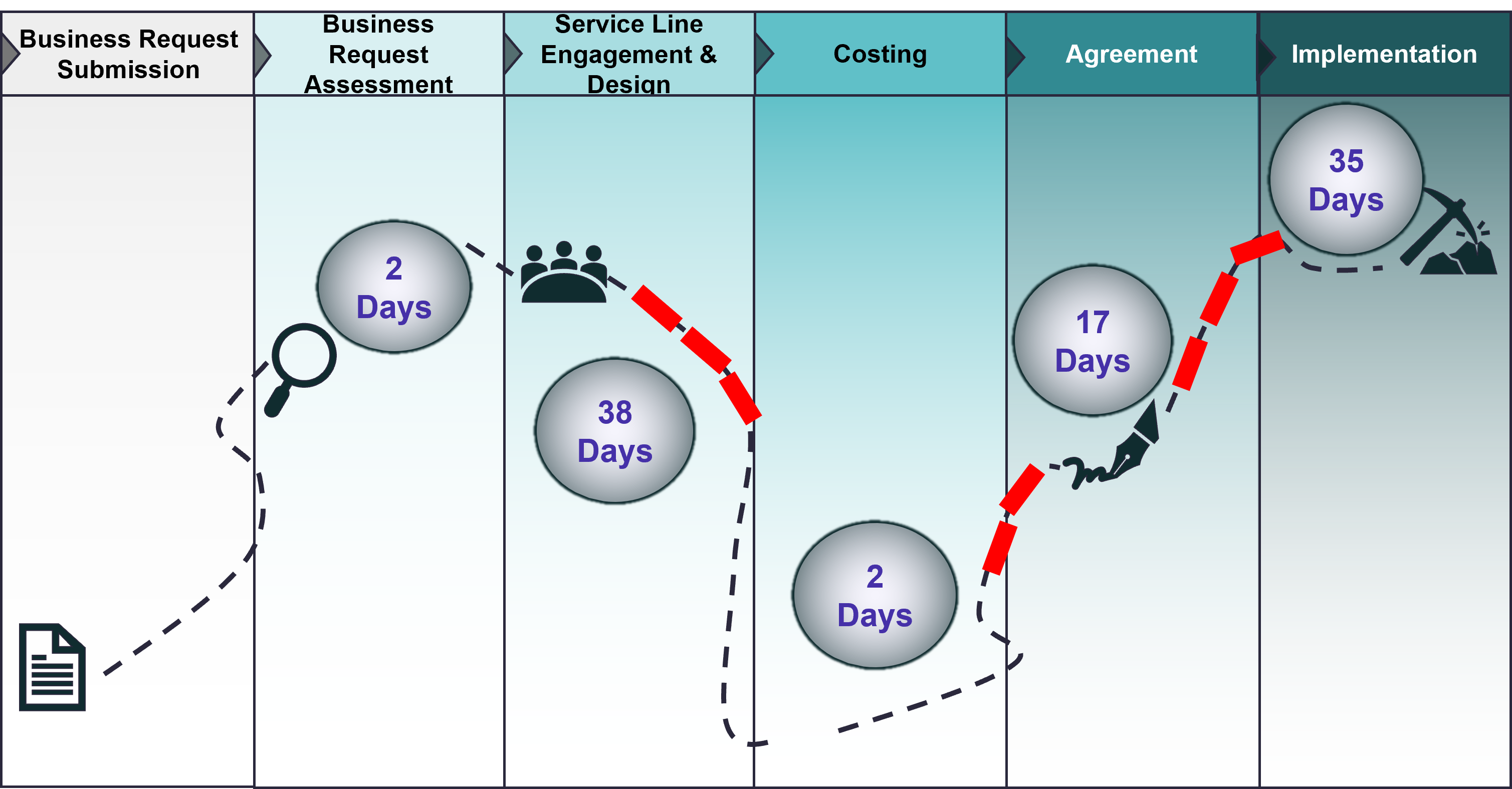
Long Description
There were inefficiencies in the assessment and design stages
The Business Request Assessment stage in the BR process was affected if information was unclear or insufficient
A business request document had to be completed by partners for SSC to accurately scope and cost the work. Upon submission, multiple levels of review at the assessment stage took place. While the Enterprise Business Intake Review Board made great progress with the development of its template, interviewees reported that business request documents often suffered from unclear and insufficient information. This would lead to rejection which forced the business request to start again at the intake stage. Each time a rejection occurred, one week could be added to the timeline and multiple discussions among partners, Service Delivery Managers, and services lines were often required. There was no time recording, so it is unclear what resource costs were incurred for these delays. While these reported inefficiencies were not unique to the pandemic, they affected SSC’s ability to deliver services in a more efficient manner during the COVID-19 response.
Service Line Engagement and Design was impacted by limited documentation, workflows, and silos
While the time duration of all other stages in the business intake process was reduced during COVID-19, the median time for the design stage increased from 34 days in 2019-20 to 38 days in 2020-21. According to interviewees, limited documentation on workflows impacted proper identification and engagement with service lines.
The Business Intake Tracking System (BITS) was used to monitor business requests as they progressed through the process. Interviewees believed that, when used appropriately, the system was excellent in project workflows. It would also allow for communication of business request status to the client. However, all Service Delivery Managers who participated in the case study stated that the system was not used effectively by service lines. As a result, it often required them to communicate with service lines using alternative methods. In addition, tracking business requests from intake to implementation was difficult as there was no direct link between business tracking numbers in the BITS and the ticket tracking numbers used by services lines.
“Writing a business request document is a form of art.”
“[BITS] would be amazing if everybody could use it!”
Cancellations lead to churn and wasted work
Costing was impacted by changes in scope, unexpected costs, and cancellations
The time required for SSC to generate a cost estimate was perceived by partners as one of the key obstacles in the BR process, which impacted their own ability to plan. Interviewees provided several examples of how the costing stage complicated the BR process. In one example, changes in scope from the client required an amended business request document in order to receive adjusted costs, adding 11 months to the overall timeline of the business request. In another example, when the costing information provided by SSC to partners was deemed too high, it led to the business request being cancelled.
It is important to note that SSC did not collect revenue until implementation was completed. This took typically 42 days and consumed many SSC employees’ time and energy. While it is unrealistic to expect all business requests would be implemented, an analysis of administrative data revealed that 17% of all business requests were cancelled during the pandemic (2020-21 to 2021-22). Among these, about half were cancelled directly after the costing stage and prior to an agreement and revenues for the department. In total, about 9% of business requests did not lead to revenues for the department.
The entire business request process was impacted by the “backlog”
Interviewees noted that a backlog of business requests carried over year after year existed. There was a common perception among interviewees that the backlog was impacting SSC’s service delivery. While the evaluation could not identify the proportion of business requests that were delayed due to limited capacity, administrative data confirmed that a backlog of business requests indeed existed and that it was steadily increasing over time.
Excluding any business requests with a target implementation date two or more years after the submission date, administrative data analysis revealed that the proportion of business requests “backlogged” year over year has been increasing over time.
The “backlog” of business requests yet to be implemented two or more fiscal years after submission
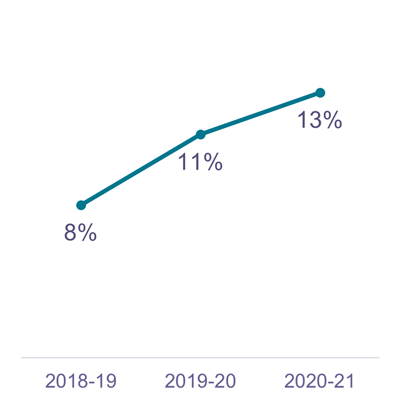
Long Description
- 2018-19
- 8%
- 2019-20
- 11%
- 2020-21
- 13%
Emerging Issues and Considerations
During data collection of the evaluation, interview and survey respondents brought forward several issues that were outside of the focus of the evaluation. While these issues were not directly related to SSC’s COVID-19 response, they could have important implications for future operations.
Partners expressed concerns about strategic needs and insufficient communications
Partners believed that SSC has been too focused on urgent operational needs and not enough on their long-term strategic needs
There was a perception among both SSC staff and partner organizations that SSC had become intensely operations focused due to the high volume of service demands during the pandemic. As a result, this limited the Client Executives’ ability to strategically plan and anticipate future business demands by partner organizations.
When some partner organizations proposed business requests that addressed an anticipated organizational need, they reported that these requests had either been declined by SSC or required escalation in order to be accepted. SSC’s service delivery was therefore perceived as lacking proactive solutions.
In the client survey conducted for the evaluation, partners were asked for their perspectives on a variety of topics related to the responsiveness, effectiveness and efficiency of SSC’s COVID-19 response. Compared to all other surveyed topics, the lowest satisfaction ratings were reported for SSC’s ability to provide proactive solutions (31%).
While support for the Enterprise approach grew, there was a need for increased communication on changes and the strategic roadmap
SSC’s pandemic response reinforced the value of an enterprise-wide approach. However, there was a commonly held perception among interviewed partner organizations of the need for SSC to improve communications on future milestones and the new Enterprise Service Model.
Interviewees stated that, while standard communications were available, there was a need for more substantial information to help them understand what to expect. Interviewees mentioned a lack of clarity around what changes would be brought on by new service models; how these changes would be implemented; what processes would be involved; as well as what the partner organizations would be expected to do in order to be prepared. They also indicated their lack of information about key milestones has impacted their ability to conduct financial investment planning.
“SSC acts like fire fighters – focusing on emergency as opposed to being more proactive.”
“SSC’s response was very ad hoc and reactive and required frequent inquiries to understand SSC’s approach to resolving issues.”
Partners expressed concerns about SSC’s ability to meet their unique needs
Partners continued to ask for more of a balance between standardized and customized solutions.
The Enterprise approach was designed to focus on serving the common needs of across departments and agencies at speed and scale, while still allowing enough flexibility to address unique departmental requirements.
According to interviews, partners believed there was a need for better balance between standardized enterprise solutions and customized services. For example, for partners that operate in complex international, regional, or border contexts, it was perceived that SSC’s Enterprise approach was not well adapted to their reality.
In addition, there was a general perception among partner interviewees that SSC tended to “do everything for everyone”. They expressed concerns that such an approach could impede SSC’s ability to provide customized solutions.
At the same time, there was sometimes a lack of appreciation and acceptance among partner organizations that SSC might need to take into account other considerations besides client satisfaction. Specifically, SSC senior management monitored and paid close attention to client satisfaction throughout the evaluation period. However, client satisfaction was not the only factor in decision-making during the pandemic. SSC decisions were also based on what was believed to be best for the enterprise, stewardship requirements, and cost considerations.
In the absence of additional information on outcomes and impacts on partner organizations, the delivery of their programs, and services to Canadians; it was difficult for the evaluation to determine the extent to which SSC had struck the right balance between partner and enterprise needs.
“We would have liked more direct support from SSC on the establishment of this complex solution [split tunnelling] based on our unique departmental needs.”
“More direct engagement and better understanding of our needs would be good.”
Conclusions and Recommendations
Responsiveness and Effectiveness
The evaluation found that Shared Services Canada (SSC) played a very responsive and effective role in supporting federal departments and agencies in providing critical services to Canadians. The pandemic placed unprecedented demands on the Government of Canada IT infrastructure as departments and agencies rapidly implementing new programs and services to support Canadians. SSC rose to the challenge and pivoted quickly to the shifting needs and requirements.
As SSC’s strategic vision, SSC 3.0 was the cornerstone for enabling responsive and effective action. It provided a strategy for an Enterprise approach to IT by concentrating work on three service transformation priorities: networks and security, workplace collaboration tools, and digital service delivery. These priorities allowed SSC to focus its operational efforts and actions around the most critical aspects of the pandemic response. By focusing on these priorities, SSC demonstrated remarkable speed, agility and dedication in its delivery of pandemic-related critical services.
Performance Measurement
SSC does not currently measure the impact of its performance and its contributions as a service provider to the achievement of business outcomes in partner organizations. Instead, customer satisfaction is used as a proxy to measure the immediate and intermediate outcomes arising from SSC services and programs. Based on data collected from customer satisfaction instruments, SSC’s support for departments and agencies to deliver critical services during the pandemic was effective. At the same time, there is a need to collect outcome data in order to enable meaningful measurement of performance and impacts.
Recommendation:
Engage selected partners in the development of outcome measures of SSC’s performance. These measures are intended to demonstrate how SSC supports departments and agencies in delivering mandates and how SSC contributes to the delivery of GC priorities.
Sustainability
The speed of service SSC demonstrated in responding to urgent needs during COVID-19 was unsustainable. As demand for SSC’s services has continued to increase, stakeholders expressed concerns that SSC does not have the capacity required to meet current and future demand. While the disequilibrium between capacity and demand was not unique to COVID-19, the impact of the pandemic exposed this gap. A review of SSC’s demand prioritization strategy is needed to facilitate effective allocation of scarce resources in a post-crisis context.
Recommendation:
Review and revise SSC’s demand prioritization strategy to align resource allocation with SSC’s longer-term core responsibilities to ensure that the highest value activities can be delivered.
Efficiency
Given sustainability challenges, it will be imperative for SSC to use its existing resource envelope in the most efficient manner. The evaluation found there were opportunities to improve efficiency in the various stages of the business intake process. A review of the business request process is needed to mitigate impacts on SSC’s service delivery model.
Recommendation:
Review the business intake process to identify and address inefficiencies. This could include:
- Ensure consistent use of business request documentation and tools, such as the Business Intake Tracking System.
- Further streamline and standardize processes to expedite time required to complete business requests.
- Develop clear, welldocumented workflows (such as organizational charts and contact information) to allow appropriate identification and engagement of service lines.
- Develop criteria and mechanisms to reduce the number of business requests submitted by partners.
Enterprise Approach
During data collection for the evaluation, interview and survey respondents brought forward several issues concerning the direction of the Enterprise approach. While these issues were not directly related to SSC’s COVID-19 response, they could have important implications for future operations. Specifically, partners expressed concerns that SSC was too focused on operational needs and not enough on their strategic needs. In addition, partners continued to ask for more balance between standardized and customized solutions as well as more understanding of the Enterprise Service Model. Going forward, there is a need to improve communications on the new Enterprise Service Model.
Recommendation:
Develop a communications strategy for the Enterprise Service Model that clearly details future changes to service delivery and the strategic milestones to support longer-term planning.
